History
The area of nowadays Beek en Donk has been inhabited for a long time. Tools of Stone Age nomadic people have been found. The first permanent inhabitants come around 700 AD. In the Middle Ages, the basis was made for the current towns. First Beek grew around the Oude Toren, and Heereind. In the 13th century, the role of Heereind was taken over by the expanding Donk. Heereind is noted in a document in 1314, where it was given the same importance as Aarle, Rixtel and Beek. On Saint Barbara day (December 4) in 1300, duke Jan II of Brabant gave the inhabitants of 'Rikestele, Arle ende Beke' (Rixtel, Aarle and Beek) the right to use common lands around the towns. In the 14th century, Beek en Donk got its first church. In 1809, it was demolished, but the tower remains, like the Oude Toren (old tower)
During the reign of Johanna van Brabant, Beek was together with Aarle and Stiphout, was sold to Dirk de Roovere, for 1.700 gulden. In later ages, the area changed owners a few times, until in 1798 the feudal system was abolished, inspired by the French revolution.
During the 80-year war, the town suffered from passing enemy armies. After the war, Beek en Donk remained poor. Only in the late 18th century, when there was more land cultivated, the situation slowly got better. In the 19th century, the town started to develop more. In 1836 the Zuid-Willemsvaart was dug by hand, and in 1880-1881, the steam tram between Den Bosch and Helmond was built, having a stop in Beek en Donk. The tram was broken up later; the canal still remains.
In 1997, Beek en Donk, Lieshout, Aarle-Rixtel and Mariahout formed the municipality Laarbeek. The town hall of Beek en Donk serves as the town hall of the new municipality.
In 2020, at a future construction site in Beek en Donk, phosphor was found in the ground at the site, dating back to explosives used by Germans during World War II. The construction was postponed.

Kampen is a city and municipality in the province of Overijssel, Netherlands. A member of the former Hanseatic League, it is located at the lower reaches of the river IJssel.
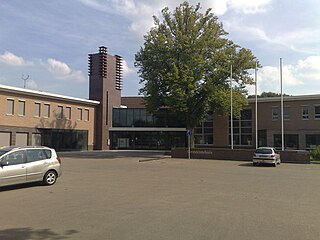
Eersel is a municipality and a town in southern Netherlands in the province of North Brabant. Eersel is situated in the Campine (Kempen) area.

Laarbeek is a municipality located in the province of North Brabant in the south of the Netherlands. It was formed in 1997 from the former municipalities Beek en Donk, Aarle-Rixtel and Lieshout. Laarbeek is part of the city region 'Samenwerkingsverband Regio Eindhoven', centered on the city of Eindhoven. The town hall is located in Beek en Donk.

Oirschot is a municipality and a town in the southern Netherlands. It is situated 12 kilometres (7.5 mi) from the city of Eindhoven and 20 kilometres (12 mi) from the city of Tilburg in the province North Brabant (Noord-Brabant). The municipality had a population of 18,623 in 2019.

Sint-Oedenrode is a town in the province of North Brabant.

Goeree-Overflakkee is the southernmost delta island of the province of South Holland, Netherlands. It is separated from Voorne-Putten and Hoeksche Waard by the Haringvliet, from the mainland of North Brabant by the Volkerak, and from Schouwen-Duiveland by Lake Grevelingen.

Puttershoek is a town and former municipality in the western Netherlands. It is located on the banks of the Oude Maas, on the island Hoeksche Waard, in the province of South Holland. On January 1, 1984, the municipality of Puttershoek was merged with several others into Binnenmaas. With 6,293 inhabitants Puttershoek was the largest settlement in the municipality of Binnenmaas until 's-Gravendeel joined Binnenmaas in 2007. Since 1 January 2019, it is part of the new municipality Hoeksche Waard.

Erp is a town in the southern Netherlands, in the province of North Brabant between 's-Hertogenbosch and Eindhoven. Prior to 1994, Erp was a municipality consisting of the town of Erp and the villages of Boerdonk and Keldonk. In that year, the municipality was merged with the municipality of Veghel to form one municipality under the latter name. The area of the former municipality of Erp has a population of 6,663, while Veghel has a population of 37,655.

The Aa is a small river in the Netherlands. It rises near Nederweert in the southeastern province of Limburg, in the Peel region. It flows northwest through the province of North Brabant towards 's-Hertogenbosch, roughly along the Zuid-Willemsvaart canal. In 's-Hertogenbosch, at the confluence of the Aa and the Dommel, the river Dieze is formed, which flows into the Meuse a few km further. The main cities and towns along the Aa's course are Asten, Helmond, Veghel and 's-Hertogenbosch.
Prinsenbeek is a village and a former municipality in the Dutch province North Brabant. The village is situated west of the motorway A16 (Rotterdam–Antwerp) and the TGV line Amsterdam–Paris. Prinsenbeek is a part of the municipality Breda, and it has 11,419 inhabitants (2005). There is a train station on the line Rotterdam–Breda. During the carnival, Prinsenbeek is called Boemeldonck (slowtrainswamp).
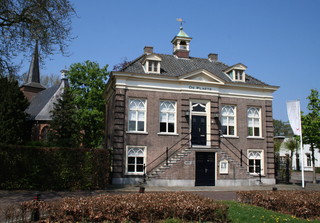
Berlicum is a town in the south of the Netherlands, located in North Brabant's Meierij region near the city of s-Hertogenbosch and the river Aa. The town was most likely founded between 600 and 700 AD. It was a municipality along with the village of Middelrode until a large-scale municipal reorganisation in 1996, when Berlicum and neighbouring Den Dungen merged with the municipality of Sint-Michielsgestel. In 2009, Berlicum had 9,743 inhabitants.
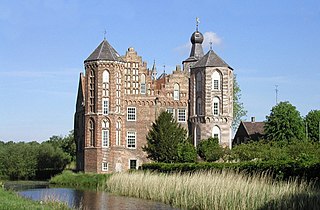
The castle Croy is a castle in the Dutch province North Brabant, near the village Aarle-Rixtel which is part of the municipality of Laarbeek. From 1642 until 1968 Croy belonged to the municipality Stiphout.
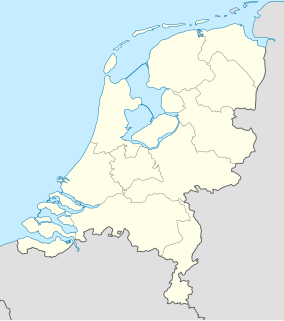
Someren-Eind is a small town, located in the southeast of North Brabant, Netherlands. It is a part of the gemeente Someren, counting 3510 residents by 2007. Someren-Eind is located near the Zuid-Willemsvaart, a canal that connects 's-Hertogenbosch and Maastricht. Someren-Eind is also known under the name D'end.
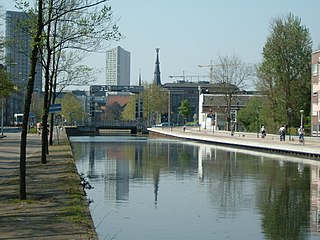
The Eindhovensch Kanaal is a canal in the Dutch province of North Brabant. It connects the center of Eindhoven with the Zuid-Willemsvaart. It was dug in the period 1843-1846, commissioned by the town of Eindhoven. The canal is 13.9 kilometers long and runs by a number of Eindhoven industrial areas and the towns of Geldrop, Mierlo and Helmond. The canal runs over the Kleine Dommel and the Goorloop, which are led under the canal by ducts.
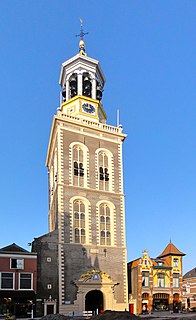
The Nieuwe Toren is located at the Oudestraat in the city of Kampen, in the Netherlands. This Carillon tower was built in the period between 1649-1664 partly according to a design by Philips Vingboons. The lower brick-built part was erected by the Edam mill maker Dirck Janzn. The design for the lantern was made by Philips Vingboons, which may have originally been intended for the Town hall now the Royal Palace of Amsterdam. The construction work went through many setbacks, the work even came to a standstill during the period 1655-1660. It was declared a Dutch National Monument (Rijksmonument) in 1972.

Sint-Oedenrode is a moderately urbanized city and capital of the former municipality of the same name in the province of North Brabant. The city is located in the Meierij of 's-Hertogenbosch. Sint-Oedenrode counts 17,928 inhabitants and has an area of 64.25 km². The municipality has traditionally city rights since 1232, and was known as a "Vlek" in the past. Today it is still a large town. From southeast to northwest, the city is split by the river the Dommel.

Donk is a township in the municipality of Mol in the province of Antwerp in Belgium. Donk resides at the southern side of the Bocholt–Herentals Canal and is an industrial area, especially in past.

Sint-Michielsgestel is a village in the municipality of Sint-Michielsgestel, Netherlands.























